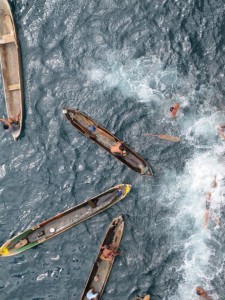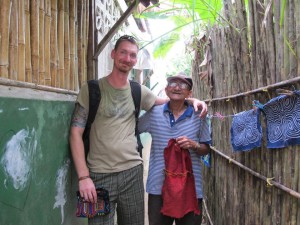 |
| San Blas Islands, Panama |
Juxtaposition can be quite humbling. I was slightly surprised by our half day stop in the San Blas Islands, located just a few miles off of the Caribbean cost of Panama, since it wasn’t on my radar originally. The day started a bit slow, and I was resting in the room when my new ship friends, Steve and Traci, called to tell me to take a look out my window. When I did, I saw two wooden canoes with little boys in each one, begging for money then diving into the water after coins that fellow shipmates tossed overboard. It was a sight unlike any I have ever seen before.
We went to the top of the ship to see more of the surrounding scenery and found the number of native boats multiplied and the families that were in them were all calling out “mOney, mOney” from below us. The backdrop had pieces of land sprouting up from the water, most of which could not have been more than a mile long. From afar I would not have guessed that people lived on these small islands, but I soon found out that they were in fact the home of the Kuna Indians.
The tenures took us to one of the small floating masses and as we approached I realized that there were small huts with walls made from sticks and roofs of brown palms. Some were covered by scrap metal and others had simple cloth material for walls. We stepped off of the boat and instantly walked through an isle of children and families calling out the familiar “dOllar, dOllar” in hopes to sell various hand crafted goods. Everything they could offer was presented, from hand carved toy boats, to coloring pages held by toddlers, and most prominently, an array of brightly sewn tapestries called Molas, which the tribe is famed for.
The entire island was a marketplace offering variations of the same products. Children held tropical birds on their heads asking for “dOllar for picture,” and an old women held a monkey for the same sell (which of course I caved to). Steve, Traci and I walked up and down each hut crevice in the village and found a native man who was happy to take us on a tour of his home. I did not see a single bed, only hammocks hanging from walls, and what he called the kitchen was nothing more than a three walled cabin filled with sticks and hanging laundry. The women wore bright colored wraps and some withered faces were ornamented with piercings and paint.
The floors were either covered in dirt or simply made of it, both inside and outside the homes. “Ocean front” property became a whole new concept, shorelines littered with trash and debris. The only signs of modern technology were the oddly placed bright red satellite dishes that were mounted between huts. You almost wonder if it is more of a spectacle than a way of living, but I know that is not the case, just a few minor luxuries in an otherwise primitive world. The Kuna Indians have survived in these islands for hundreds of years and have had only glimpses of our comparatively wealthy lifestyle through often ignorant tourists. It is a blessing to be welcomed into their wold, for as strange as it may be, these seemingly far off tribes are in fact our not so distant worldly neighbors.





